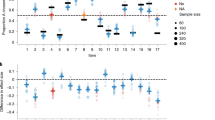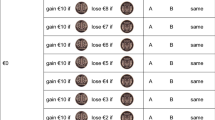Abstract
Prospect Theory (PT) is widely regarded as the most promising descriptive model for decision making under uncertainty. Various tests have corroborated the validity of the characteristic fourfold pattern of risk attitudes implied by the combination of probability weighting and value transformation. But is it also safe to assume stable PT preferences at the individual level? This is not only an empirical but also a conceptual question. Measuring the stability of preferences in a multi-parameter decision model such as PT is far more complex than evaluating single-parameter models such as Expected Utility Theory under the assumption of constant relative risk aversion. There exist considerable interdependencies among parameters such that allegedly diverging parameter combinations could in fact produce very similar preference structures. In this paper, we provide a theoretic framework for measuring the (temporal) stability of PT parameters. To illustrate our methodology, we further apply our approach to 86 subjects for whom we elicit PT parameters twice, with a time lag of 1 month. While documenting remarkable stability of parameter estimates at the aggregate level, we find that a third of the subjects show significant instability across sessions.
Similar content being viewed by others
References
Abdellaoui M. (2000) Parameter-free elicitation of utility and probability weighting functions. Management Science 46(11): 1497–1512
Abdellaoui M., Vossmann F., Weber M. (2005) Choice-based elicitation and decomposition of decision weights for gains and losses under uncertainty. Management Science 51(9): 1384–1399
Abdellaoui M., Barrios C., Wakker P. (2007a) Reconciling introspective utility with revealed preference: Experimental arguments based on prospect theory. Journal of Econometrics 138(1): 356–378
Abdellaoui M., Bleichrodt H., Paraschiv C. (2007b) Loss aversion under prospect theory: A parameter-free measurement. Management Science 53(10): 1659–1674
Abdellaoui M., Bleichrodt H., L’Haridon O. (2008) A tractable method to measure utility and loss aversion in prospect theory. Journal of Risk and Uncertainty 36(3): 245–266
Andersen S., Harrison G., Lau M., Rutström E. (2008a) Lost in state space: Are preferences stable?. International Economic Review 49(3): 1091–1112
Andersen S., Harrison G., Lau M., Rutström E. (2008b) Eliciting risk and time preferences. Econometrica 76(3): 583–618
Anderson L., Mellor J. (2009) Are risk preferences stable? Comparing an experimental measure with a validated survey-based measure. Journal of Risk and Uncertainty 39(2): 137–160
Barseghyan, L., Price, J., & Teitelbaum, J. (2008). Are risk preferences stable across contexts? Evidence from insurance data. Working Paper, Cornell University. American Economic Review (forthcoming).
Bassler, J. F., MacCrimmon, K. R., & Stanbury, W. T. (1973). Risk attitudes of business executives. Fourth International Conference on Subjective Probability, Utility, and Decision Making. Rome, Italy.
Baucells M., Villasís A. (2010) Stability of risk preferences and the reflection effect of prospect theory. Theory and Decision 68(1-2): 193–211
Becker G. M., Degroot M. H., Marschak J. (1964) Measuring utility by a single-response sequential method. Behavioral Science 9(3): 226–232
Berg J., Dickhaut J., McCabe K. (2005) Risk preference instability across institutions: A dilemma. Proceedings of the National Academy of Sciences 102: 4209–4214
Blavatskyy P. (2006) Error propagation in the elicitation of utility and probability weighting functions. Theory and Decision 60(2): 315–334
Bleichrodt H., Abellan-Perpinan J. M., Pinto-Prades J. L., Mendez-Martinez I. (2007) Resolving inconsistencies in utility measurement under risk: Tests of generalizations of expected utility. Management Science 53(3): 469–482
Booij A., van de Kuilen G. (2009) A parameter-free analysis of the utility of money for the general population under prospect theory. Journal of Economic Psychology 30(4): 651–666
Bruner D. (2008) Changing the probability versus changing the reward. Experimental Economics 12(4): 367–385
Brunnermeier M. K., Nagel S. (2008) Do Wealth fluctuations generate time-varying risk aversion? Micro-evidence on individuals. American Economic Review 98(3): 713–736
Camerer C. (1998) Prospect theory in the wild: Evidence from the field. In: Kahneman D., Tversky A. (eds) Choices, values, and frames. Cambridge University Press, Cambridge
Camerer C., Hogarth R. (1999) The effects of financial incentives in experiments: A review and capital-labor-production framework. Journal of Risk and Uncertainty 19(1-3): 7–42
Chateauneuf A., Cohen M. (1994) Risk seeking with diminishing marginal utility in a non-expected utility model. Journal of Risk and Uncertainty 9(1): 77–91
Dave, C., Eckel, C., Johnson, C., & Rojas, C. (2010). Eliciting risk preferences: When is simple better? Working Paper, University of Texas at Dallas, University of Arizona, University of Massachusetts Amherst.
Deck, C., Lee, J., Reyes, J., & Rosen, C. (2009). Measuring risk attitudes controlling for personality traits. Working Paper, Florida International University.
Dohmen, T., Falk, A., Huffman, D., Schupp, J., Sunde, U., & Wagner, G. (2009). Individual risk attitudes: Measurement, determinants and behavioral consequences. Working Paper, Maastricht University. Journal of the European Economic Association (forthcoming).
Eckel C., Wilson R. (2004) Is trust a risky decision?. Journal of Economic Behavior & Organization 55(4): 447–465
Erner, C., Klos, A., & Langer, T. (2010). Can prospect theory be used to predict investor’s willingness to pay? Working Paper, University of Muenster.
Goldstein D., Johnson E., Sharpe W. (2008) Choosing outcomes versus choosing products: Consumer-focused retirement investment advice. Journal of Consumer Research 35(3): 440–456
Gonzalez R., Wu G. (1999) On the shape of the probability weighting function. Cognitive Psychology 38(1): 129–166
Grable J., Lytton R. (2001) Assessing the concurrent validity of the SCF risk tolerance question. Financial Counseling and Planning 12(2): 43–53
Grayson C. (1960) Decisions under uncertainty: Drilling decisions by oil and gas operators. Harvard University Graduate School of Business, Boston
Guiso L., Paiella M. (2006) The role of risk aversion in predicting individual behavior. In: Chiappori P.-A., Gollier Christian (eds) Insurance: Theoretical analysis and policy implications. MIT Press, Boston
Harbaugh W., Krause K., Vesterlund L. (2007) The fourfold pattern of risk attitudes in choice and pricing tasks. The Economic Journal 120(545): 595–611
Harrison G., Johnson E., McInnes M., Rutström E. (2005) Temporal stability of estimates of risk aversion. Applied Financial Economics Letters 1(1): 31–35
Hershey J., Kunreuther H., Schoemaker P. (1982) Bias in assessment procedures for utility functions. Management Science 28(8): 936–954
Hershey J., Schoemaker P. (1985) Probability versus certainty equivalence methods in utility measurement: Are they equivalent?. Management Science 31(10): 1213–1231
Holt C., Laury S. (2002) Risk aversion and incentive effects. American Economic Review 92(5): 1644–1655
Holt C., Laury S. (2005) Risk aversion and incentives: New data without order effects. American Economic Review 95(3): 902–912
Isaac M., James D. (2000) Just who are you calling risk averse?. Journal of Risk and Uncertainty 20(2): 177–187
James D. (2007) Stability of risk preference parameter estimates within the Becker-DeGroot-Marschak procedure. Experimental Economics 10(2): 123–141
Kruse J., Thompson M. (2003) Valuing low probability risk: Survey and experimental evidence. Journal of Economic Behavior & Organization 50(4): 495–505
Lauriola M., Levin I., Hart S. (2007) Common and distinct factors in decision making under ambiguity and risk: A psychometric study of individual differences. Organizational Behavior and Human Decision Processes 104(2): 130–149
Luce D. (1999) Utility of gains and losses: Measurement-theoretical and experimental approaches. Lawrence Erlbaum Associates, Mahwah, NJ
Malmendier, U., & Nagel, S. (2010). Depression babies: Do macroeconomic experiences affect risk-taking? Working Paper, NBER. Quarterly Journal of Economics (forthcoming).
McGlothlin W. (1956) Stability of choices among uncertain alternatives. The American Journal of Psychology 69(4): 604–615
Morone, A. (2009). On price data elicitation: A laboratory investigation. Working Paper, Munich Personal RePEc Archive.
Nosic A., Weber M. (2008) How risky do I invest: The role of risk attitudes, risk perceptions and overconfidence. Decision Analysis 7(3): 282–301
Sahm, C. (2007). How much does risk tolerance change? Working Paper, Federal Reserve Board.
Schechter L. (2007) Risk aversion and expected-utility theory: A calibration exercise. Journal of Risk and Uncertainty 35(1): 67–76
Schmidt U., Zank H. (2008) Risk aversion in cumulative prospect theory. Management Science 54(1): 208–216
Sharpe, W., Goldstein, D., & Blythe, P. (2000). The distribution builder: A tool for inferring investor preferences. Working Paper, Stanford University.
Slovic P. (1972) Information processing, situation specificity, and the generality of risk-taking behavior. Journal of Personality and Social Psychology 22(1): 128–134
Smidts A. (1997) The relationship between risk attitude and strength of preference: A test of intrinsic risk attitude. Management Science 43(3): 357–370
Stott H. (2006) Cumulative prospect theory’s functional menagerie. Journal of Risk and Uncertainty 32(2): 101–130
Swalm R. (1966) Utility theory—insights into risk taking. Harvard Business Review 44(6): 123–136
Tversky A., Kahneman D. (1992) Advances in prospect theory: Cumulative representation of uncertainty. Journal of Risk and Uncertainty 5(4): 297–323
van de Kuilen, G., & Wakker, P. (2009). The midweight method to measure attitudes towards risk and ambiguity. Working Paper, Tilburg University, Erasmus University.
Vlaev I., Chater N., Stewart N. (2009) Dimensionality of risk perception: Factors affecting consumer understanding and evaluation of financial risk. Journal of Behavioral Finance 10(3): 158–181
von Gaudecker, H., van Soest, A., & Wengstrom, E. (2008). Selection and mode effects in risk preference elicitation experiments. Working Paper, Tilburg University, Center for Economic Research.
Wakker, P. (2010) Prospect Theory: For risk and ambiguity. Cambridge University Press.
Weber E., Blais A. -R., Betz N. (2002) A domain-specific risk-attitude scale: Measuring risk perceptions and risk behaviors. Journal of Behavioral Decision Making 15(4): 263–290
Wehrung D., MacCrimmon K., Brothers K. (1984) Utility assessment: Domains, stability, and equivalence procedures. INFOR 22(2): 98–115
Wolf C., Pohlman L. (1983) The recovery of risk preferences from actual choices. Econometrica 51(3): 843–850
Wu G., Zhang J., Gonzalez R. (2004) Decision under risk. In: Harvey N., Koehler D., The Blackwell handbook of judgment and decision making. Oxford University Press, Oxford
Author information
Authors and Affiliations
Corresponding author
Rights and permissions
About this article
Cite this article
Zeisberger, S., Vrecko, D. & Langer, T. Measuring the time stability of Prospect Theory preferences. Theory Decis 72, 359–386 (2012). https://doi.org/10.1007/s11238-010-9234-3
Published:
Issue Date:
DOI: https://doi.org/10.1007/s11238-010-9234-3




